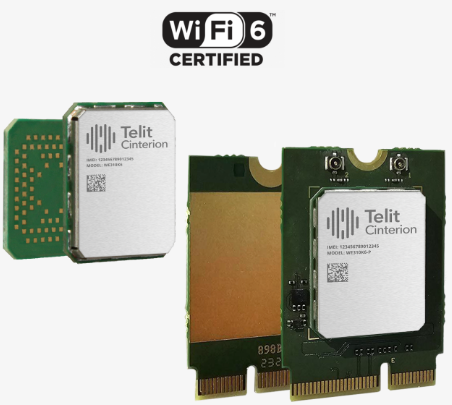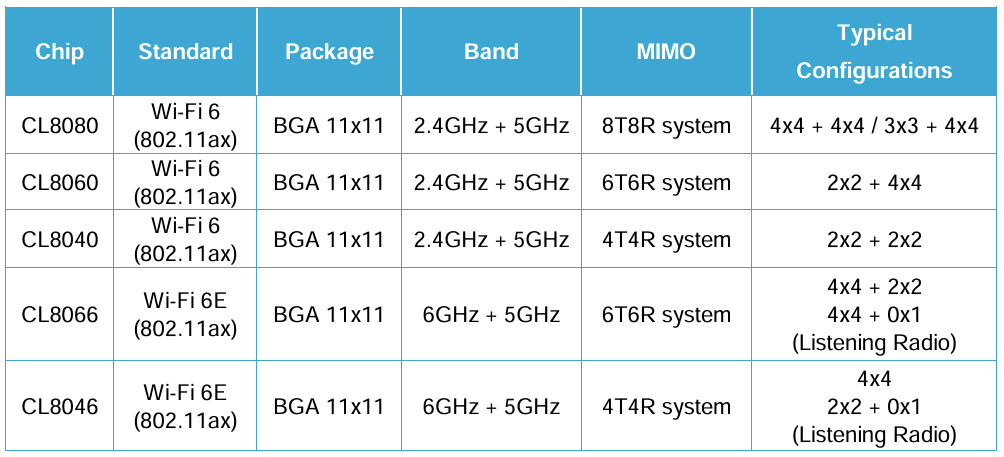This last FAQ in this series will cover Broadcom, Telit Cinterion, and Renesas’s latest innovations in Wi-Fi connectivity solutions for IoT applications. These innovations continue to focus on Wi-Fi 6 and 7 technologies, which offer improved speed combined with other features.
Broadcom: BCM43740/43720/47722/6765/6726/67263
Broadcom’s BCM43740/43720/47722/6765/6726/67263 are the latest versions of the company’s Wi-Fi modules, featuring Wi-Fi 7 technology. The modules support a special SpeedBooster™ to enhance Wi-Fi connection speeds, as shown in Figure 1. Specifically, it allows 160 MHz devices to utilize the entire 320 MHz access point capacity, doubling the Wi-Fi connection speed.

The BCM43740/43720 series provides enterprise-level performance needed for more extensive IoT operations. Full multi-band support (2.5/5/6 GHz) ensures that the best frequency is chosen based on the needs of each IoT device and the conditions in the surroundings.
With its 4×4 setup and up to 11.5 Gbps PHY rate, BCM43740 can connect many IoT devices simultaneously. The 320 MHz channel bandwidth allows for IoT apps that use more data, such as video surveillance or real-time monitoring systems.
The BCM43720, featuring a 2×2:2 configuration and 2.89 Gbps maximum PHY rate, is more appropriate for battery-powered IoT sensors where power efficiency is paramount and smart home devices with moderate bandwidth requirements.
The BCM47722 can handle Bluetooth Low Energy, Zigbee, Thread, and Matter protocols, making building an IoT network much easier. It saves time and complexity by avoiding using separate protocol gateways.
This connection works especially well in business settings where different IoT devices must work together without problems. Support for three links in multi-link operation makes connections more reliable, which is important for mission-critical IoT apps.
The BCM6765’s specs work well with small — to medium-sized IoT setups. It has two 2×2 tri-band radios that are powerful enough for most home or small business IoT applications. The 10 Gbps Ethernet PHY ensures data transfer works well, helping connected IoT devices run smoothly.
The BCM67263/BCM6726 series offers unique options for certain IoT deployment situations. The BCM67263’s focus on the 6 GHz band makes it better for IoT apps that need clean spectrum access in crowded areas. The BCM6726’s flexible band support lets it work in a wide range of RF environments while still delivering excellent performance at up to 11.5 Gbps PHY rate.

Because of these qualities, Broadcom’s Wi-Fi modules (Figure 2) work well for IoT applications where managing the spectrum and avoiding interference are important. Additionally, the built-in quad-core ARMv8 CPU of BCM47722 and BCM6765 lets IoT data be processed locally, reducing cloud dependencies and delays.
Telit Cinterion: WE310K6-P
The WE310K6-P Wi-Fi module (Figure 3) has a data rate of up to 1201 Mbps and a dual-stream spatial multiplexing feature, which is very useful for current IoT applications that need to send large amounts of data quickly. It supports 2.4 GHz and 5 GHz frequencies and Wi-Fi 6 (802.11ax), which is very helpful for IoT deployments.

The 2.4 GHz band has a longer range and can better penetrate walls, which is important for smart home control, where devices may be spread throughout a building. The 5 GHz band, on the other hand, has faster data rates and less interference, which makes it better for apps that need a lot of bandwidth, like security cameras or industrial automation systems.
Form factor choices (LGA package and M.2) give designers more freedom when making devices. This lets manufacturers pick the best way to integrate their IoT products, whether making a small wearable device or a bigger industrial controller.
The module’s 19 dBm output power at 2.4 GHz and 8 dBm output power at 5 GHz make it a good choice for IoT deployments. These power levels provide enough coverage for most IoT setups while keeping power use under control, which is essential for devices that run on batteries.
The module can work as an access point (AP), a station (Client), or both at the same time (AP+STA mode). This is very helpful in IoT settings where devices may need to build networks and connect to existing infrastructure. For example, a smart home hub could join the home router as a client and give IoT sensors a place to connect locally simultaneously.
The module’s industrial-grade temperature range (-40°C to +85°C) makes it perfect for IoT applications in harsh conditions, like outdoor environmental monitoring systems or industrial automation equipment. The security features, like WPA3 support and built-in crypto hardware, meet the important need for strong security in IoT deployments.
Renesas: CL8000 product family
The Renesas CL8000 product family consists of CL8080, CL8060, CL8040, CL8066, and CL8046 chips integrated with Wi-Fi 6 (802.11ax R2) connectivity. The CL8000 architecture (Figure 4) lets the two Wi-Fi radios work separately, so they can be used as AP+AP, AP+STA, AP+Repeater, or AP+Listening Radio (Spectrum Intelligence), which makes the device more useful and flexible in the spectrum.

802.11ax supports beamforming, target wake time (TWT), trigger-based scheduling, 1024QAM, and 160MHz. It also supports MU-OFDMA and MU-MIMO. Dynamic MAC and PHY changes in Renesas’ architecture improve throughput and coverage in crowded areas, ensuring that the CL8000 product family provides a high-quality experience anywhere, anytime, and on any device.
The product family combines two MACs, two PHYs, analog, and RF in one package. It also has the necessary CPUs and memories to run more wireless LAN functions on-chip, offering a strong host offloading option.
It comes in a small 11×11 BGA package with a PCIe 3.0 interface, which simplifies system design and execution and makes it useful for many IoT devices. This integration and backward compatibility ensure that the system will work in the future and is easy to add to current ones.

Figure 5 shows the table comparing the features of the CL8000 product family, highlighting the key differences in the bandwidth, MIMO type, and applicable configurations.
Summary
Broadcom has realized that the speed can be increased within the existing Wi-Fi 7 space using its proprietary SpeedBooster™ technology. Therefore, they offer a variety of Wi-Fi modules to meet various needs in IoT applications, such as connectivity speed and cost of deployment. Telit Cinterion’s Wi-Fi modules are available with LGA and M.2 packages, which makes them product-fit. With its CL8000 product family, Renesas has enriched the Wi-Fi module by combining multiple MACs and PHYs. Its built-in CPU and memory add to the efficient management of tasks and workloads.
References
Connected by Broadcom, new Wi-Fi chipset solutions enable next generation smartphone and access point platforms to expand market adoption, Broadcom
BCM43740/BCM43720 4×4 and 2×2 802.11be Wi-Fi 7 enterprise access point chips, Broadcom
BCM47722: Dual 2×2 320MHz Wi-Fi 7 quad-core ARM SoC with dual IOT radio, Broadcom
4×4 802.11be Wi-Fi 7 residential access point chips BCM67263/BCM6726, Broadcom
Dual 2×2 320MHz Wi-Fi 7, quad-core ARM SoC | BCM6765, Broadcom
CL8000 Product Family – Wi-Fi 6/6E, Renesas
WE310K6-P download zone, Telit Cinterion
Related EE World Online content
What you should know about Wi-Fi 6 and the 6-GHz band
Verify, test, and troubleshoot 5G Wi-Fi FWA gateways
What’s new with Wi-Fi 6? Focus on high-efficiency
How can Wi-Fi sense without sensors?
Testing Wi-Fi 6E performance

Leave a Reply